I've Been Visiting New Orleans for 20 Years. Here Are My Favorite Neighborhoods, Restaurants, Bars, and Music Venues
Though best known for Mardi Gras and its rollicking French Quarter, New Orleans now has a new polish, with boutique hotels and globally minded bars and restaurants.
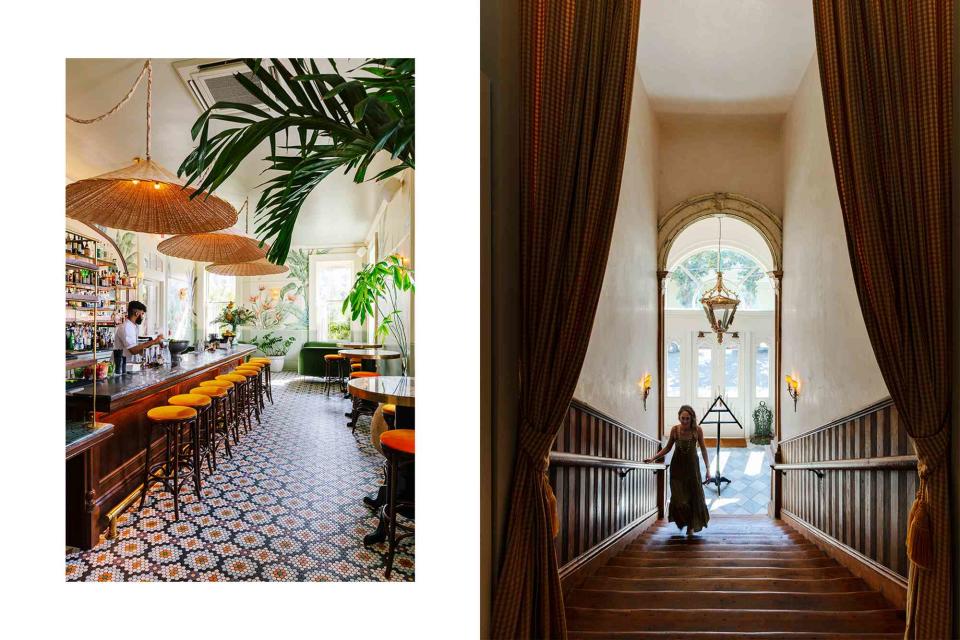
Cedric Angeles
From left: The Paradise Lounge at Hotel Saint Vincent, in the Garden District of New Orleans; stairs leading to the entrance of Hotel Peter & Paul, in the Marigny.New Orleans is always a good idea, I told myself, even as I landed in the Southern port city on a particularly sultry mid-June day. Inside the gleaming new Louis Armstrong International Airport, I was greeted by a few unmistakable geographical reminders: a Café Du Monde counter frying its signature powdered-sugar-dusted beignets, an outpost of Bar Sazerac slinging its namesake drink, and a spirited four-piece brass band playing by baggage claim. Settling into my Uber, I asked the driver to crank up WWOZ, a station owned by the New Orleans Jazz & Heritage Foundation. “Take It to the Streets,” a horn-heavy track by a group of Treme musicians named the Rebirth Brass Band, ushered me into town.
I first visited New Orleans roughly 20 years ago, when I was in college and could slurp down Pat O’Brien’s sugar-laced Hurricanes with gusto. In my mid 20s, I returned as an enthusiastic Jazz Fest attendee. In my early 30s, I finally made it inside Galatoire’s — the famed jacket-required institution where tuxedoed waiters serve shrimp rémoulade to society ladies — and Preservation Hall, a family-run venue for jazz performances. In recent years, I’d heard that the Big Easy had evolved beyond the familiar trappings of the French Quarter and embarked on a sophisticated new chapter that my 40-something self would find deeply appealing.
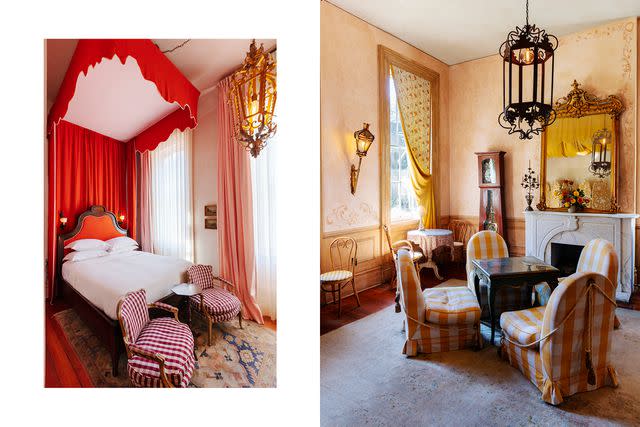
Cedric Angeles
From left: The Rector's Repose guest room at Hotel Peter Paul; antique European seating in the Elysian Bar.Like New York City, New Orleans has a deep and distinct sense of place — as it should at the ripe old age of 304. “The city is one very long poem,” Bob Dylan wrote in his autobiography, perhaps nodding to the romance of its cast-iron balconies, hidden courtyards, and crumbling cemeteries. Or maybe he was thinking about the petunia-scented air and fabled voodoo culture. New Orleans remains full of French, Spanish, British, Caribbean, Sicilian, and African influences, many of which can be experienced through its elaborate street parades and a bona-fide musical heritage: rhythm and blues, bounce, funk, and jazz.
The spectrum of cultures can be felt just as strongly in the food and drink. The 1,400-plus restaurants run the gamut from iconic steak houses (Charlie’s, Crescent City Steaks) to Vietnamese stalwarts (Tan Dinh and Dong Phuong) to Creole (Dooky Chase’s) and Cajun mainstays (Cochon). But in the years since Hurricane Katrina, the offerings have become even more eclectic. Partial credit for this evolution goes to chef Nina Compton, whose French-Caribbean eatery Compère Lapin debuted in 2015, along with chef Alon Shaya’s Saba, Mason Hereford’s playful sandwich shop, Turkey & the Wolf, and Melissa Martin’s Mosquito Supper Club, which put a family-style spin on Cajun cooking and helped popularize the idea of communal dining in the city.
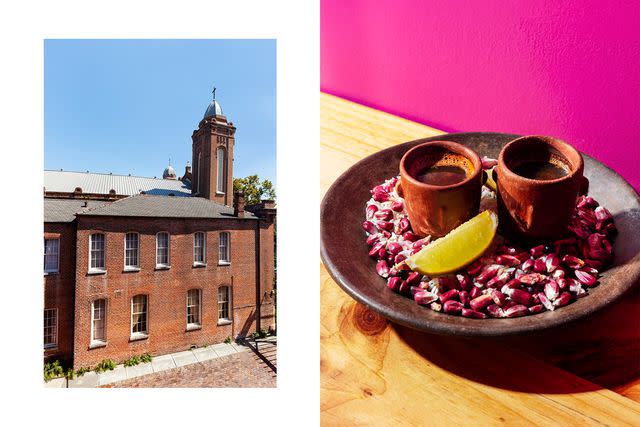
Cedric Angeles
From left: A former rectory has been transformed into the Elysian Bar; coffee served on a bed of uncooked maize at Lengua Madre, a modern Mexican restaurant in the Garden District.Around the same time, bars began hosting more pop-up restaurants, giving chefs temporary places from which to launch their careers in an economically viable way. The flexibility of the arrangement led to greater creativity and the inclusion of people with different backgrounds. Serigne Mbaye’s Senegalese-Cajun Dakar NOLA, for instance, grew out of pop-up in a bar. “A lot of young chefs came out taking swings after COVID,” chef Ana Castro told me when I visited her two-year-old modern Mexican spot Lengua Madre.
Related: The Best Times to Visit New Orleans
The hotel scene has witnessed a similar evolution. For decades, New Orleans hotels were mostly big-box brands clustered around the French Quarter and Central Business District. This shifted in 2016, when the Roman & Williams–designed Ace Hotel opened in the once-neglected Warehouse District. In 2019, Ace introduced its dressier sibling, the 67-room Maison de la Luz. Now a fresh crop of boutique hotels, many with local owners, serve as community anchors in the gentrifying Faubourg Marigny and the once-sleepy Garden District and Uptown neighborhoods. These recent arrivals meant I could wake up with the most intriguing pockets of the city right outside my door. Last summer, I spent a week taking it all in.
Faubourg Marigny and the Bywater
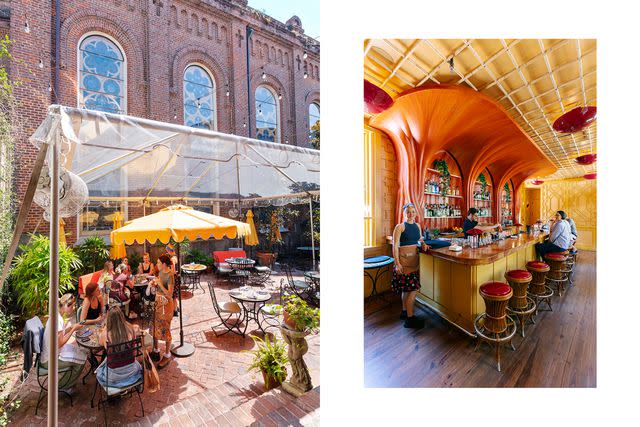
Cedric Angeles
From left: The garden of Elysian Bar, at Hotel Peter & Paul, which is housed in a former church and school complex; mixing drinks at the Elysian Bar.Lined with Creole cottages and pastel shotgun houses, Faubourg Marigny (often referred to as the Marigny) is one of the earliest neighborhoods in New Orleans, established in the early 1800s by French colonizers. These days, it’s a hot spot for up-and-coming music venues, indie restaurants, and dive bars. Many credit writer-hotelier Nathalie Jordi for starting the area’s revival in 2018 with Hotel Peter & Paul, for which she painstakingly restored buildings from the 1860s that had been used by the Catholic Church. The hotel’s 71 rooms (designed by ASH NYC and NOLA-based StudioWTA) feature wrought-iron beds, armoires painted with trompe l’oeil, and custom gingham fabrics. The old rectory is now the amber-toned Elysian Bar, run by the folks behind the beloved Bywater bottle shop and wine bar Bacchanal. Light dishes (snapper crudo, smoked-beet tartare) are served in two parlors, a tiny glass atrium, and a lush courtyard.
After dinner one night, I walked to Frenchmen Street, a scruffy two-block stretch where the French Quarter meets the Marigny. I hopped from the standing-room-only Spotted Cat Music Club to D.B.A., a two-decade-old venue where artists like Corey Henry & the Treme Funktet often appear. Outside, the rhythms spilled onto the streets, melting and merging into a sweet cacophony, and on the corner around midnight, I found people dancing to an impromptu brass ensemble.
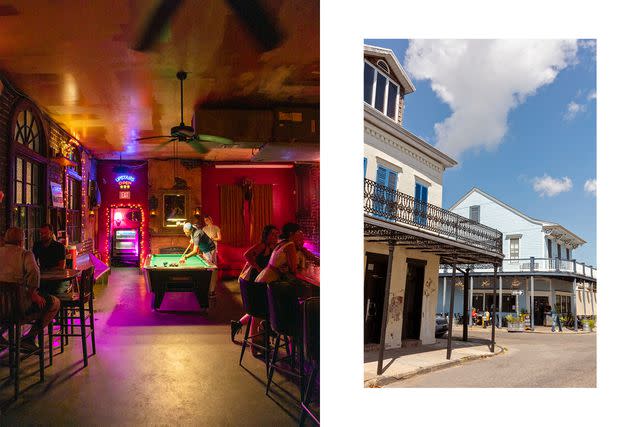
Cedric Angeles
From left: The billiards table at Anna's, a bar in the Marigny; the exterior of Alma.At breakfast and lunch, the new Little Horn, a no-fuss corner café, offers sidewalk seating for egg dishes and BLTs. Just down the street, the destination dive bar Mimi’s was recently replaced by Anna’s, another low-key hangout, whose owners have dutifully kept its previous tenant’s trimmings — including string lights, a jukebox, and a pool table — as well as a Mondays-only red-bean bowl. You can get anything from PBR on tap to a frozen espresso martini. For wine lovers, Bar Pomona offers a rotating selection of natural wines alongside cheese plates with Compagnon sourdough bread and the owner’s small-batch jams (there’s also terrific soft-serve ice cream). Last year, the pop-up Budsi’s Thai opened a permanent space on North Rampart Street serving pad see ew, drunken noodles, and assorted curries.
Beginning at Franklin Avenue, you’ll find the Bywater, the Marigny’s art-filled neighbor, which hugs the Mississippi River. Near the railroad tracks is Studio Be, a 35,000-square-foot warehouse gallery belonging to Brandan “BMike” Odums, a Black artist who has collaborated with the likes of Dave Chappelle and Chris Rock. Inside, sculptures, interactive videos, and Odums’s floor-to-ceiling graffiti-style murals depict icons like Sidney Poitier and Martin Luther King Jr. The artist is also behind Eternal Seeds, a community-based nonprofit that supports emerging young Black creatives in developing their work.
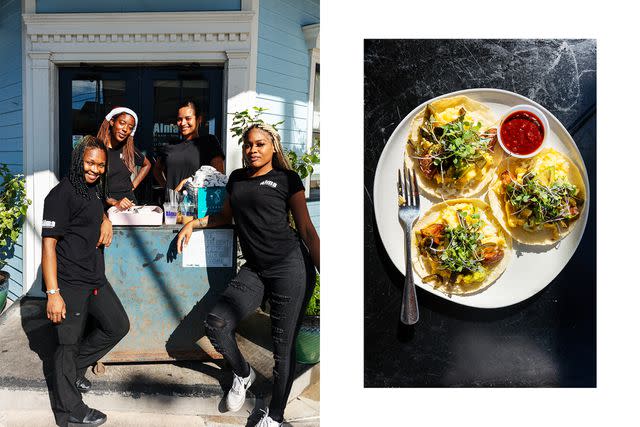
Cedric Angeles
From left: Staff at Alma, a Honduran restaurant in the Bywater; breakfast tacos at Alma.In 2020, after a successful pop-up run, chef Melissa Araujo opened the 75-seat Alma on the Bywater’s west side. An ode to her Honduran family’s cooking, the spot is known for its toast with Louisiana lump blue crab, migas with a dash of salsa macha, and direct-trade coffee from Honduras. “People want to eat and drink different things and are going into our local neighborhoods to find it,” said Araujo, who grew up in the city. “The old culinary gods are dying, and the new gods are alive.”
She wasn’t kidding. Down the street at the newly relocated Sneaky Pickle, I feasted on an array of vegan-leaning fare, including tofu-chili tacos with fermented carrot habanero sauce and a smoked-tempeh Reuben. Also nearby is the former pop-up Rosalita’s Backyard Tacos, which, last year, morphed into a brick-and-mortar California-style taco shop along St. Claude Avenue. To cool off, I stopped by the seasonal Chance in Hell SnoBalls for a zingy riff on an Arnold Palmer — a mound of shaved ice with native Luzianne tea and house-made lemon syrup.
Garden District
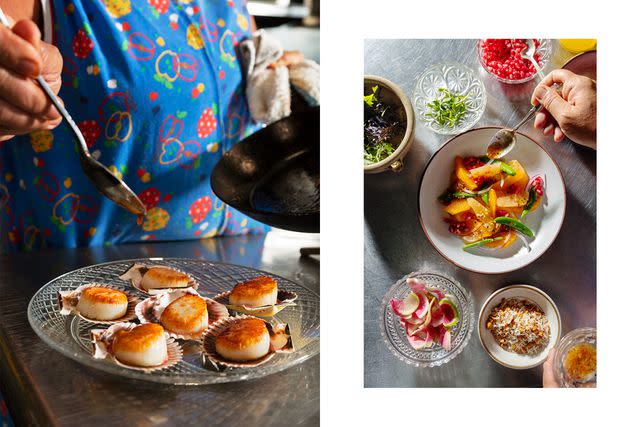
Cedric Angeles
From left: Scallops with brown butter and scallop garum at Mister Mao; a salad with grapefruit, snap peas, and pomegranate at Mister Mao.For $1.25, the olive-green St. Charles Streetcar took me from Canal Street, near the French Quarter, to the Garden District, a 19th-century residential area with elegant mansions landscaped with fragrant azaleas. Should spirits still linger in the city, they’re certainly inside the Lafayette Cemetery No. 1: a gothic-tinged, magnolia-tree-lined landmark with rows of elaborate raised tombs. Across the street, I watched a Friday-afternoon crowd descend on the storied Commander’s Palace, where chefs Emeril Lagasse and Paul Prudhomme once worked and lunchtime martinis are 25 cents.
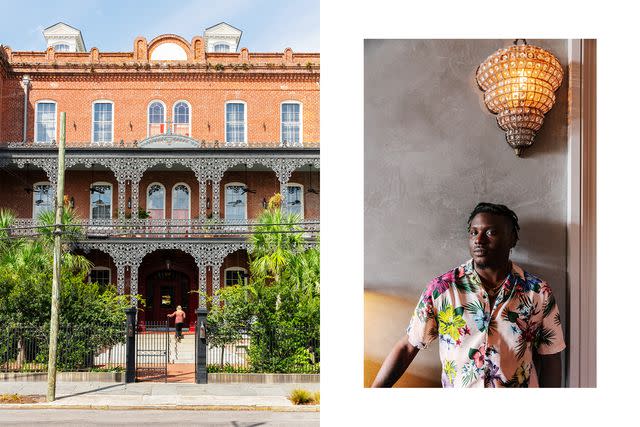
Cedric Angeles
From left: A 19th-century former orphanage is now home to Hotel Saint Vincent; Bryce Davis, the host at the San Lorenzo restaurant at Hotel Saint Vincent.On Constance Street, chef Ana Castro’s memorable five-course tasting menu at Lengua Madre nods to her paternal grandmother’s Mexican cooking. The décor is simple and sparse: a curved wooden bar, checkered tile floor, and a neon-pink-lit hallway that pays homage to architect Luis Barragán’s signature color blocks. In between bites of an earthy huitlacoche sope — a disk of fried masa dusted with chèvre, borage, and epazote — I watched the hushed theatrics of the open kitchen, where a chef was diligently plating a serving of arroz verde. “My food is nostalgia-based,” Castro reflected. “I take what I loved most in a meal and share it.” A block away, Barrel Proof, a venerable timber-clad, whiskey-leaning bar, rotates three concepts every week: the modern Asian Matchbook Kitchen; Cuban-Honduran QuePasta; and tarte flambée specialist Flamme Nola.
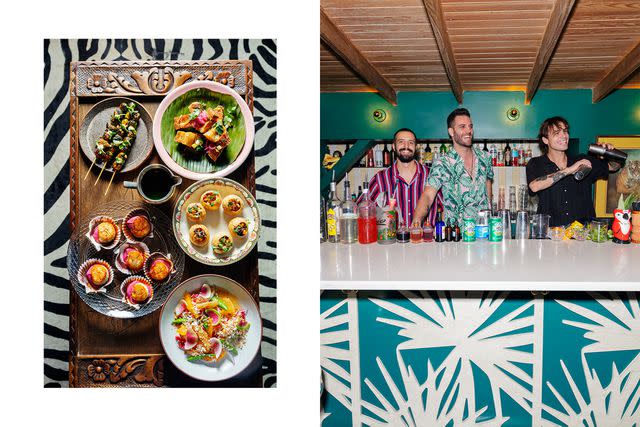
Cedric Angeles
From left: Filipino fried pork belly and crispy rounds of pani puri are on the menu at Mister Mao, in the Uptown neighborhood; a trio of bartenders at Mister Mao.On lower Magazine Street, Texas-bred hotelier Liz Lambert and her partners Larry McGuire and Tom Moorman recently transformed an 1861 redbrick orphanage with ornate wrought-iron flourishes into a stylish 75-room getaway. Hotel Saint Vincent is an Alice in Wonderland–style sensory whirlwind of charcoal-gray rooms with red velvet accents, 1970s-style bathrooms studded with coral tiles, and trippy marbled wallpaper, and downstairs, a Saltillo-tiled pool lined with striped loungers. There are two restaurants: San Lorenzo, a chic, Amalfi-inspired spot with house-made pastas; and a cheery outpost of the Austin-based Elizabeth Street Café, an all-day French-Vietnamese bakery. The grand porch of the Paradise Lounge was bustling at happy hour, while the dimly lit, guests-only Chapel Club Bar appealed to the nightcap crew.
Uptown
Just west of the Garden District, Uptown is a sprawling neighborhood with mansions and centuries-old oak trees whose boughs often dangle with blingy Mardi Gras beads. The 350-acre Audubon Park and the leafy campuses of Loyola and Tulane universities are nearby. The 1970s venue Tipitina’s (now owned by the band Galactic) remains beloved for New Orleans funk, as is the pressed-tin-walled, open-till-the-wee-hours Maple Leaf Bar, which hosts the legendary Rebirth Brass Band on Tuesdays.
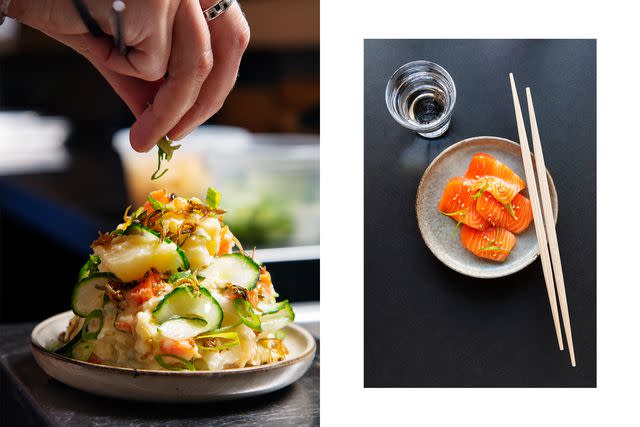
Cedric Angeles
From left: Japanese-style potato salad with niboshi at Bar Sukeban, in the Uptown neighborhood; Ora King salmon sashimi at Bar Sukeban.Last summer, Cambodian-American chef Sophina Uong opened Mister Mao, which serves a self-described “unapologetically inauthentic” mash-up of Mexican, Indian, and Southeast Asian cuisines. Small plates, such as pork chili verde with Khmer grapefruit and mango salad, are served from roving dim-sum-style carts in a pastel dining room flanked by a large tropical mural. Farther uptown, the casual new Seafood Sally’s fuses Gulf Coast and Southeast Asian cooking in dishes like raw oysters with a Vietnamese mignonette and seafood boils with Viet-Cajun chili butter. And in mid-July, Bar Sukeban opened its 16-seat izakaya with a trim menu of elevated hand rolls, sakes, and whiskies. Its chef, Jacqueline Blanchard, also operates the neighboring Coutelier, a shop that sells hand-forged Japanese cutlery.
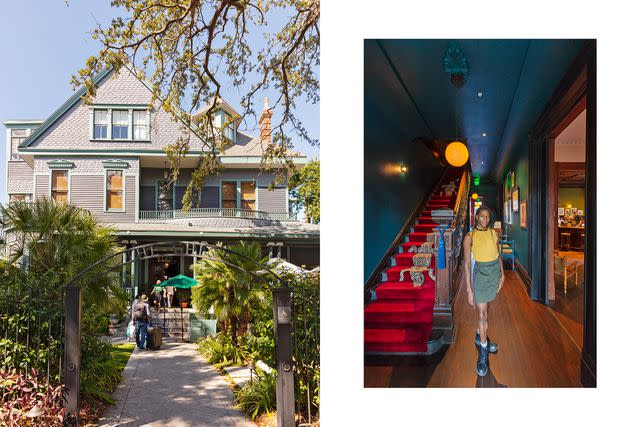
Cedric Angeles
From left: The entrance to the Chloe hotel; Kazee Taylor, a greeter, stands near a boldly carpeted staircase inside the Chloe.There’s a heap of action along Freret Street. In 2020, local musician Branden Kempt saved the concert venue Gasa Gasa from closing and kept its compact stage and monster sound system intact. That same year, the team behind Cure, largely credited for bringing the craft-cocktail scene to town in 2009, opened Vals, an airy Mexican spot in a rehabbed gas station. An especially happy happy hour had me and my fellow patrons singing along to Bananarama’s “Cruel Summer” as we feasted on fried-fish tacos and margaritas at the bar. I took one in a to-go cup (a NOLA staple) and headed to the garden terrace of the newly renovated, 20-room Columns, which is housed in a gleaming white 19th-century Italianate mansion. I spent an early evening noshing on caramelized-onion dip with potato chips and a delightful tuna crudo while watching the St. Charles streetcar rumble by.
More Trip Ideas: 14 Black-owned Businesses to Visit in New Orleans
A few blocks away, I dropped my bags at the Chloe, which has to be one of the friendliest places in town. The hotel — another charming Victorian mansion — opened in 2020, the first property from local restaurateur Robert LeBlanc and designer Sara Ruffin Costello (a Nashville outpost is currently in the works). A deep-red stair runner emblazoned with alligators led me upstairs to one of the 14 spacious rooms decked with four-poster beds and turntables with vinyl (Lil Wayne, Louis Armstrong) courtesy of nearby Peaches Records.
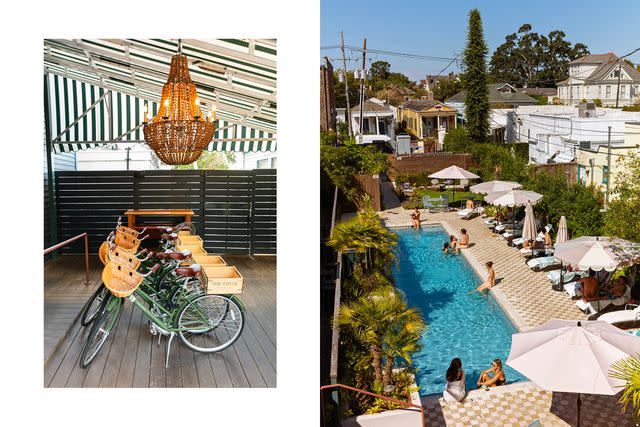
Cedric Angeles
From left: Bicycles for guests outside the Chloe hotel; the pool at the Chloe.The Chloe also has a grand tiled porch for languid afternoons, a clubby mahogany bar for cocktails, and a restaurant with cooking by veteran chef Todd Pulsinelli, whose double-stacked burgers are a must. Out back, a tropical bar and lemon-tree-lined pool draw an inclusive mix of guests and locals (the hotel offers a handful of pool passes each day). On a lazy Sunday, I lounged between two Mid-City women sipping hair-of-the-dog daiquiris and a hotel employee on her day off who kindly shared her shrimp-étouffée dumpling order with me.
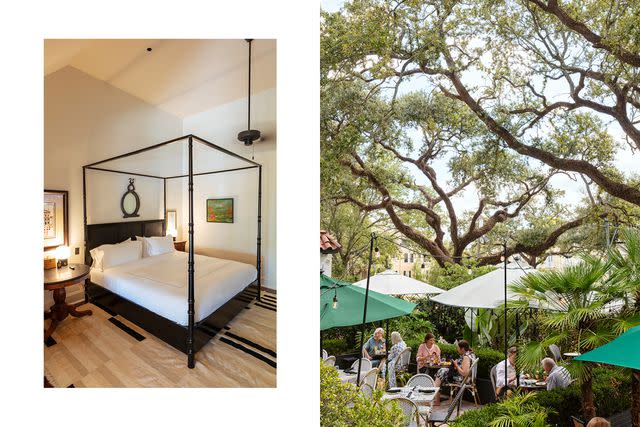
Cedric Angeles
From left: One of the Chloe hotelâs guest rooms; the courtyard of the restaurant at the Chloe.On my last morning, a rowdy thunderstorm caused the lights to flicker inside the hotel parlor — a reminder that even amid all its modern updates, the Crescent City retains its old- meets new-world charm. As I climbed into another Uber to return to the airport, I couldn’t help smiling. New Orleans wasn’t about to forget its roots anytime soon.
A version of this story first appeared in the May 2023 issue of Travel + Leisure under the headline "Easy Does It."
For more Travel & Leisure news, make sure to sign up for our newsletter!
Read the original article on Travel & Leisure.

